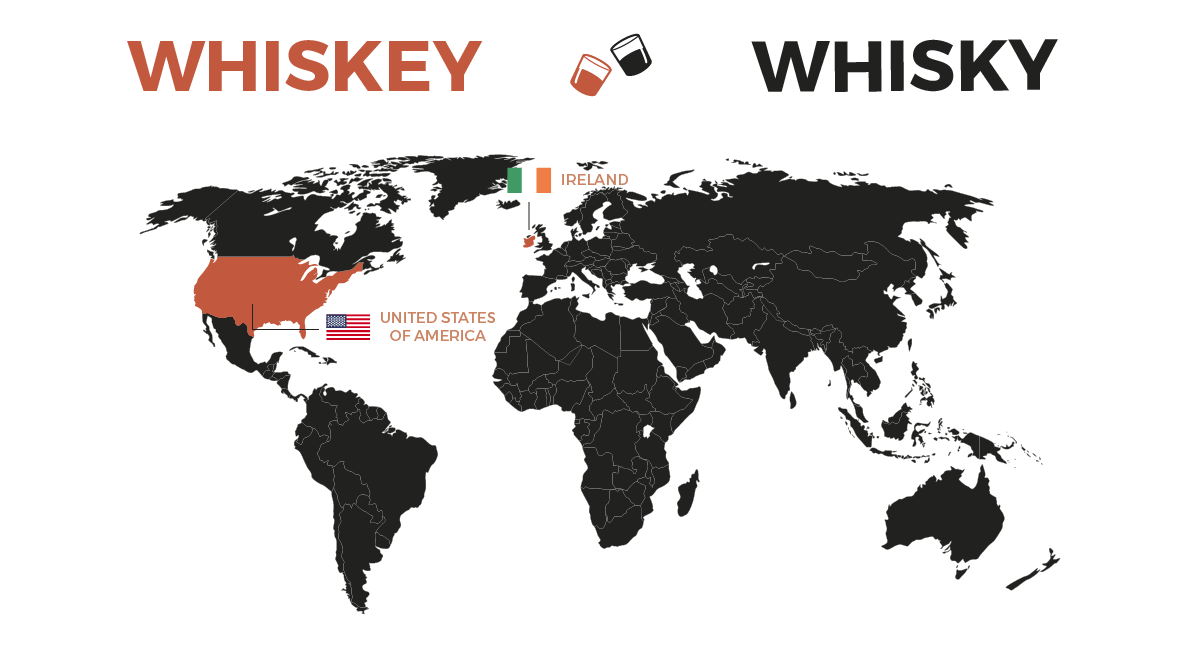Before taking your first sip of whisky/whiskey, let us first consider all of the features and classifications that you need to know in order to understand this amazing tipple.
Let’s begin with the obvious problem of understanding the difference between whisky and whiskey.
When choosing which name to use, the general rule is that those that are made in Ireland or the United States are called whiskey and those from Scotland, Canada or Japan are called whisky.
The reason for this dates way back to 1875 when Ireland added the extra “e” into the spelling in order to help distinguish their produce from that of their Scottish counterparts in the American market.
It is important to note, however, that this is not a hard and fast rule and can and has been broken from time to time.
Although alcohol can be produced from a large number of organic materials, whisky is predominantly produced from rye, wheat, barley, corn, or a combination of these together.
For more on the grains used in the production of whisky, consider this article.
Whiskies, even those produced side by side in the same distillery, can possess vast differences in flavour and texture.
Irrespective of the particular tasting method followed, whiskies are generally understood to contain flavours that fall within the following six flavour types, being smoke, spice, fruit, floral, sweets, or nuts.
For an explanation of how each of the previously mentioned flavour types present themselves in many bottles of whisky, consider below.
For elaboration on this point, consider this article.
| Smoke | Smoke in whisky can be broken into either wood smoke or peat smoke. Peat smoke is characterised by a distinct earthy, organic, and somewhat vegetal smokiness that is quite damp or moist in its taste and finish. Wood smoke is often reminiscent of a noticeable ashy or charcoal-like smokiness that is close to woodfire, cigar or cigarette smoke in its taste and distinctly dry in its finish |
|---|---|
| Sweets | A sweet taste in whisky can manifest itself through types of chocolate, including milk, dark or white chocolate to types of sweeteners or flavourings, including honey, sugar, or caramel |
| Spice | In whisky, spice can refer to many different types, including hot spices such as pepper or chilli, sweet spices such as vanilla or cinnamon, or herbal spices such as mint or thyme |
| Fruit | Fruit taste in whisky can refer to citrus fruits such as lemons, limes or grapefruits, common fruits such as apples or pears, baked fruits, dried fruits, or candied fruits such as Turkish delight |
| Nutty | Nutty tastes in whisky can easily be recognised as nuts such as hazelnuts, walnuts, almonds, or chestnuts, which are often compared to flavours found in some Sherry’s or Port’s |
| Floral | Floral tastes in whisky are often exemplified through natural floral types such as cut grass, fragrant and wild flowers, ferns, moss, and fungi, such as mushrooms |
Some of the most renowned whisky producers in the world today are Scotland, Ireland, America, Japan, Canada, Australia, and India although this list is not exhaustive and many countries, such as Taiwan and Germany, have started to experiment with their own versions.
Of the countries named above, those most important to consider at the start of your tasting journey are those from Scotland, America, Ireland, Canada, Japan, and Australia.
There’s much to learn before venturing into the prestigious world of Scotch whisky. Attempting to completely understand how they’re made, how they taste, and how they should be paired with food can prove to be incredibly elusive. We seek to provide some of the answers to these questions in our complete Scotch whisky guide.
American whiskey, experiencing a burgeoning growth in recent times, is a category that is sometimes overlooked by those revering the more classic single malts from Scotland. An appreciation of the different types of American whiskey, how they taste, and what foods and dishes to pair them with can be gained by reviewing our guide on American whiskey.
Although having almost been wiped out by the turn of the twenty-first century, Irish whiskey has thankfully experienced a renaissance that is making this fine drink available everywhere once more. You can find out more about how they’re classified, what they taste like, and how to match them with food in our comprehensive guide to Irish whiskey.
Having won a number of world whisky and spirit competitions, Japanese whisky’s popularity has expanded in recent times and looks set to continue to do so. Understanding these fine whiskies, including their unique production methods, how they taste, and what dishes to pair with them, can be achieved by reviewing our Japanese whisky guide.
Canadian whisky falls somewhere between Scottish whisky and American whiskey in its flavour profile and is therefore one of the most curious and unique selections of whisky in the world. When looking to find out how its made, how it tastes, and what foods it matches well with be sure to consider our complete Canadian whisky guide first.
Having seemingly come out of nowhere to rise to global interest, Australian whisky is often overshadowed by the Australian wine industry, which is much larger and far more well established. That being said, Australian whisky has much to offer us and to learn more about this wonderful category review our thorough Australian whisky guide.


